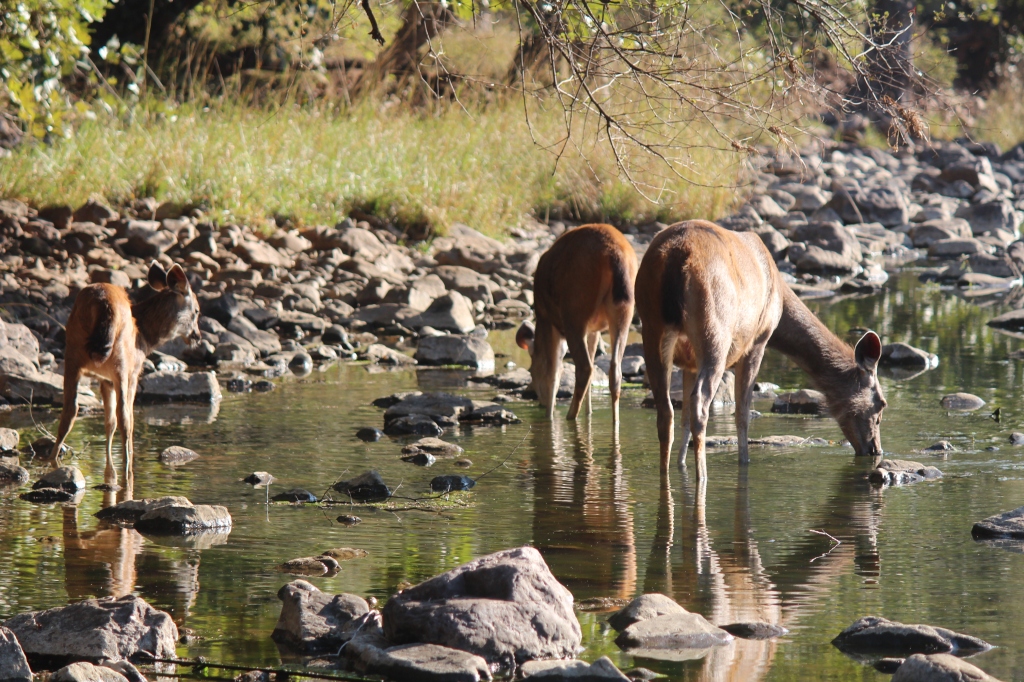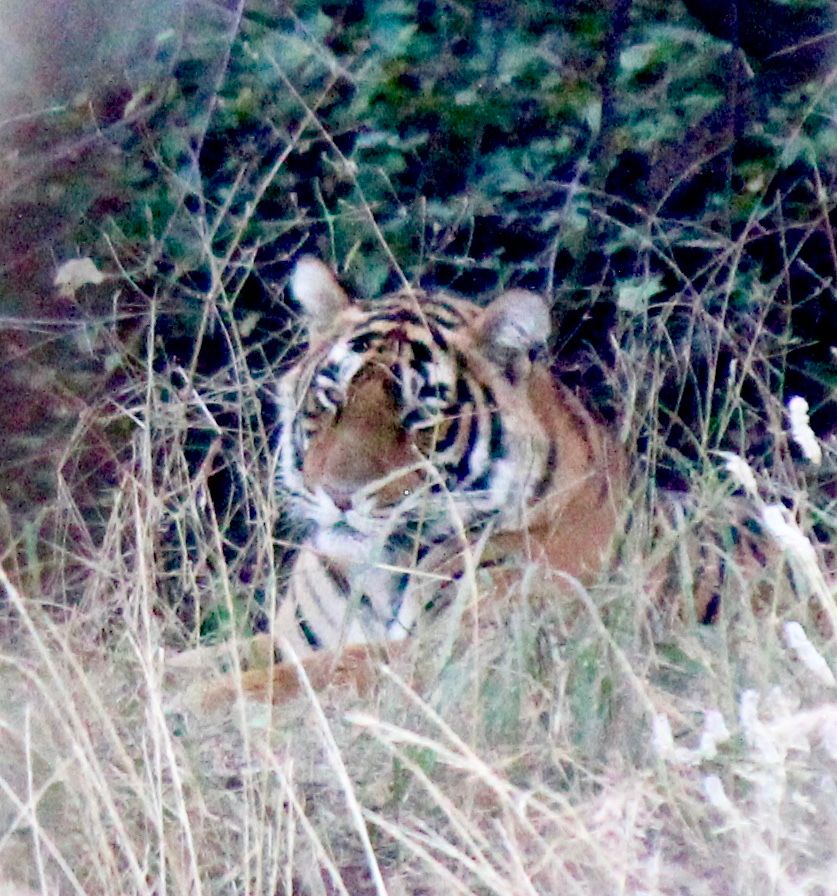It was 6 degrees at 6:45 when we gathered in the dark for our first of two game drives in Ranthambore National Park. This better be worth it, muttered my inner voice as we found a spot in the open 18-seat truck and wrapped ourselves in blankets against the cold.
We’d arrived the night before by train from Bharatpur. The famous wildlife reserve, a former royal hunting ground, lies near the town of Sawai Madhopur in Rajasthan. Along with leopards, crocodiles and countless birds, Ranthambore is home to India’s national animal, the elusive Royal Bengal tiger, which we hoped would grant us an audience.
As we bumped along the path deeper into the woods, our guide Noore, a naturalist, told us we were lucky to start the day in Zone 4 (a lottery determines which of the park’s five zones each truck enters) as we had a good chance of seeing one of the park’s 74 tigers. We were soon passing families of pretty spotted deer (chital) and big muscular sambhar deer, but he encouraged us to save our cameras for later and think big.

No tigers here! 
spotted deer

See anything moving? 
Listening for warning sounds
After 14 years on the job, Noore and his colleagues know the name and history of every tiger and its offspring in Ranthambore. Each tigress has her own territory. Males don’t stick around to parent but roam territories three times as large, making them harder to track. When the cubs are 2.5 years old, mom kicks them out of the nest, forcing them to find their own home or fight to take over hers.
About an hour into the park, we had our first break. Footprints in the sand! Great wide round prints from a Very Big Animal! The hunt was on.

SOMEONE walked by here in the past hour.
Occasionally we’d stop in a promising spot for five to 10 minutes, holding our breath and listening as we scanned trees and rocks for movement. If all was calm in the now golden morning light, deer nonchalantly munching grass, monkeys quiet, chances were slim we’d find a giant striped predator lurking.
Walkie talkies aren’t allowed in the park, so we met up regularly with other truckfuls of tourists to allow the guides to compare notes. Since they spoke in Hindi, we had no clue how close we were to actually seeing a tiger.

Comparing intel with other guides


As the morning wore on, Noore stopped more often to let us take photos of deer, a posse of squawking green parakeets, preening peacocks and long grey crocodiles sunning themselves on a riverbank. Things weren’t looking good but he wasn’t deterred. We still had a chance to find a tiger on the afternoon drive, he said cheerfully.

Back to the Tigress resort for an abundant breakfast buffet . Choices range from soupy lentils and polenta-like upma, made with semolina, to Western omelets, toast and baked beans.

dining room 
potato dosa for breakfast! 
entrance to Tigress resort
I was tempted to skip the 2 p.m. foray and relax in our spacious room, but figured if I did the others would surely come back with a sensational tiger-spotting story or two. We might as well all be disappointed together!
By now the sun was warm, no blankets needed. The road was also smoother; John from Vancouver Island was convinced this truck had better springs. We headed to a different zone, past a wall of black-faced langur monkeys waiting to be fed by locals on their way to pray at the temple. More spotted deer, some with velvety antlers. The poor things are prime tiger bait. “The only thing lower on the food chain is grass,” Noore said. No wonder they sleep on higher ground, forever watchful.

langur monkey with cheeky babe 
banyon arch
We passed a lumbering black sloth bear, which is apparently quite rare, but it was hard to get excited when we’d come for cats. More waiting, more discussion with other guides, until someone reported seeing Something moving along a ridge, either a leopard or a tiger. We made a three-point turn and headed in the direction they’d indicated. As we got close, we could hear the warning call of the sambhar deer.
Onward! By now monkeys and birds were calling their own warning. Tiger spotted! We arrived to find three jeeps in the middle of a river, at least one of the groups from France. They all stood, silently, with cameras, binoculars and cell phones trained on a patch of tall dry grass. We couldn’t see a thing, and they were in no hurry to leave. #$&%*! At last, one by one, the trucks left. Our turn to claim the prize spot, but where is she? Fortunately for us, tigress Noori, four years old and 240 pounds, seemed in no hurry to leave.

We’re next! 
Okay, where is she?
Following the guide’s instructions, I aimed my 250 mm lens at a smudge of orange against a black tree trunk. By this time everyone could see her in the distance but nobody else had a long zoom. She moved! Her head is up! Head down! She’s standing up! I just kept shooting, fighting to keep my camera focussed on the tiger and not the branches between us. Whether in focus or not, this shot was about to become The tiger picture for the whole group.

Hoping for the best 
The edited version!
At some point Noori decided she’d done enough posing and wandered off, leaving us spellbound. We actually sort-of saw a Bengal tiger! On our way back through the park, picking up speed as night was falling and the main gate closes at 5:30, we stopped one more time. In the brush in front of us, two young tigers were cavorting and eating. Though we could definitely see something thrashing around, and the guide tried his best to describe the scene, they were too far away and it was too dark for pictures.
Another amazing day in India!



WOW Cynthia – what an amazing picture! It must have taken your breath away.
You’re such an intrepid traveller! I live vicariously through your articles. 🙂
Thanks and merry christmas dear friend! The rest on Facebook
Amazing!!! Truly! When are you home? We have s treat basket for you from Spain! Xsxs Sent from my iPhone
>
Home! Trying to catch up. Still have an old delhi post to write then some highlights then … done. xxxcy
Home! xcy
Thanks for sharing your adventure with us.
Great safari story. So much suspense. That potato dosa looks divine. Merry Christmas xo
Thanks pal. Food was soo good, amazed at the number of ways Indians cook lentils and potatoes, building flavour over heat, and the incredible flavour of familiar veg, cauliflower and green beans to red carrots, sauted simply in butter. And the fresh naan, of course!
Merry Christmas xcynthia